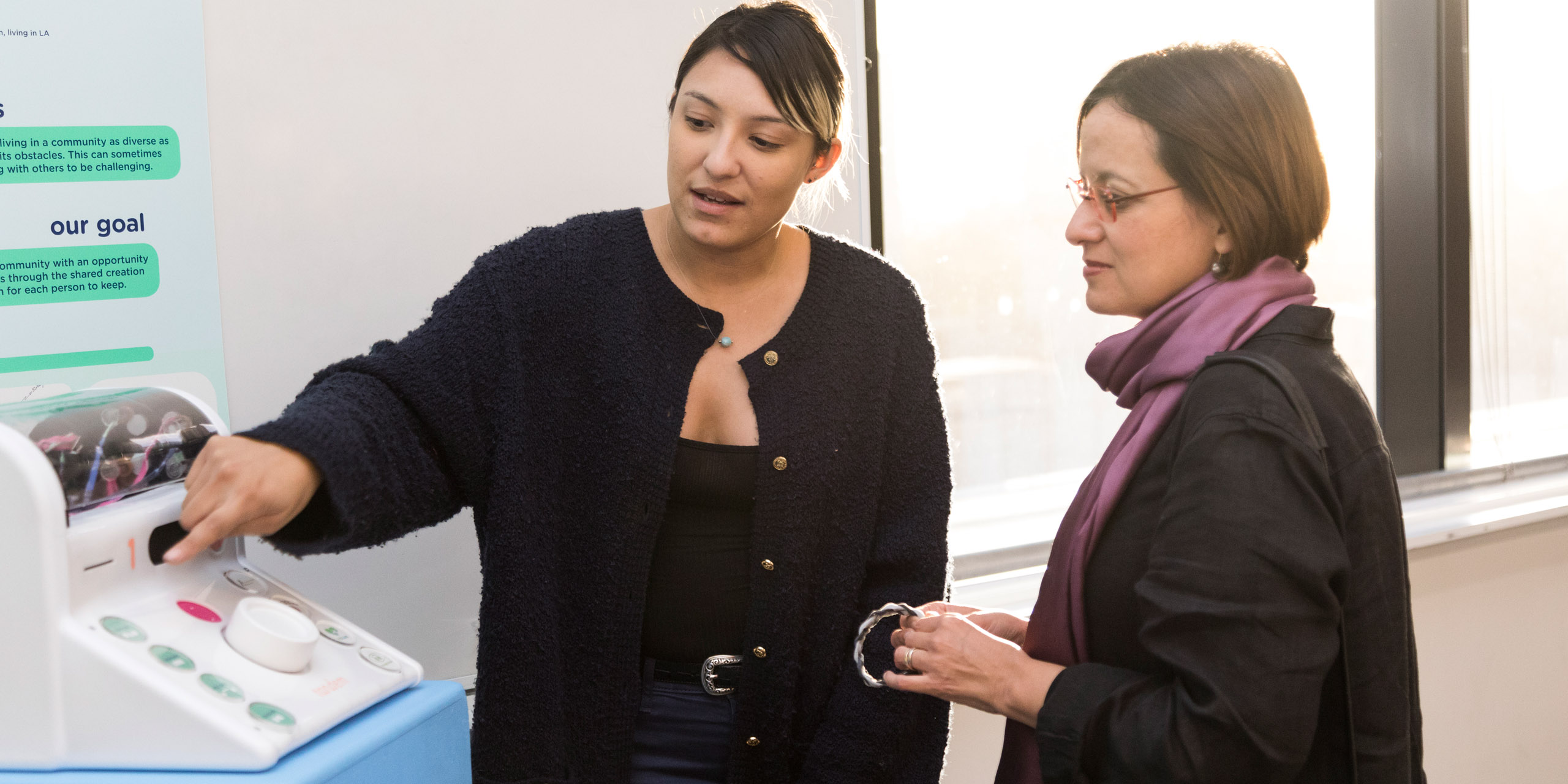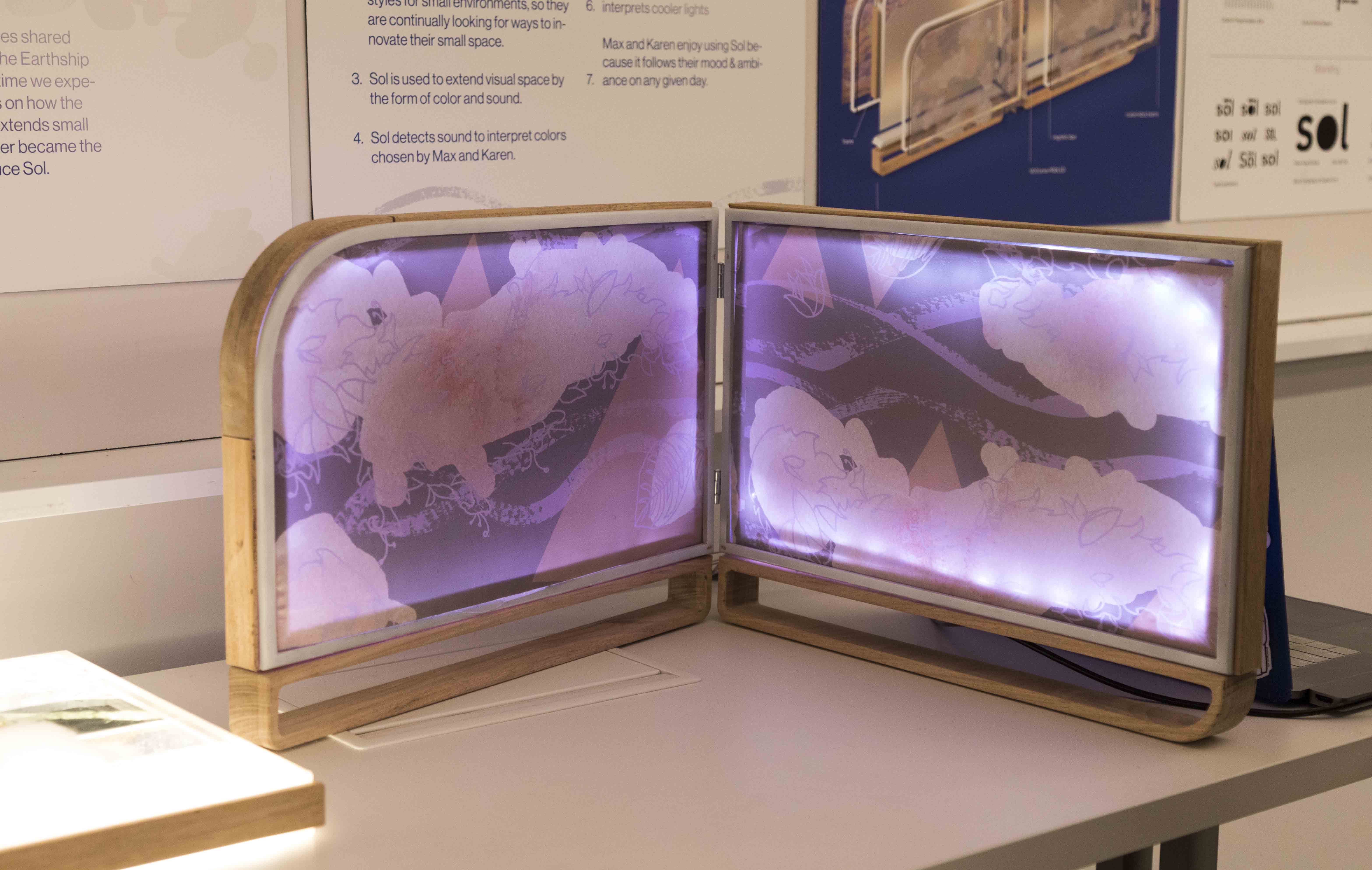Study Away: Kyoto CULTURE // CRAFT
- Social Entrepreneurship
- Sustainable Development

Fall 2017
In partnership with Kyoto Seika University (KSU), this Designmatters studio challenged ArtCenter students to culturally immerse themselves in the rich history and tradition of Kyoto craft and design. Students explored the social, ecological and cultural significance of traditional making and crafting through lectures, hands-on workshops and excursions in the historic city of Kyoto. Back in Pasadena, students employed this new knowledge to create their own textile design pattern and home goods product, items inspired by Japanese lifestyle and pop culture that also reflected a new lens of cultural sensitivity and expression.
This project was made possible in part by support from the Designmatters Educational Program Grant from the Autodesk Foundation.
Project Brief
In cooperation with Kyoto Seika University (KSU), ArtCenter students immersed themselves in Japanese culture and craft for nearly two weeks as they experienced the history and traditions of Kyoto through hands-on workshops, lectures and outings. Upon their return to ArtCenter, students drew upon their Kyoto experience to reexamine Southern California design as they created a textile design pattern and a home goods product that was inspired by Japanese lifestyle and pop culture but also reflected a new lens of cultural sensitivity and expression.

“I appreciated how the students refined their projects week after week. In reflection of the crafts that we experienced in Kyoto, the more time the students spent on refining those little elements of their design, the better the end result was.”
– Nathan Cooke, Faculty, Product Design
About Kyoto
Once the capital of Japan, Kyoto is a city on the island of Honshu. As the seat of the Imperial Court for more than 1,000 years, Kyoto was the center of Japanese power, culture and tradition; under its realm, numerous palaces, temples and shrines were built for emperors, shoguns and monks. Members of the Imperial Court were powerful patrons and practitioners of the arts and their influence resulted in the development of many popular art forms and established the high quality standards for Japanese arts and crafts. Having escaped bombing and destruction from WWII, Kyoto today deeply honors its traditional crafts heritage with artisans preserving and passing on techniques that have been handed down for centuries.
About Kyoto Seika University
A private university in Iwakua, Kyoto, Japan, Kyoto Seika University (KSU) was founded in 1968 to provide a progressive, liberal and humanistic education; it was chartered as a university in 1979. Home to 3,000 undergraduate and graduate students, KSU consists of five faculties: Art, Design, Manga, Popular Culture and Humanities as well as associated graduate schools. Design disciplines range from garden design to paper making to its pioneering manga program (a style of Japanese comic books and graphic novels). The school’s objective is to promote a spirit of independence to its students who, through intellectual and artistic learning, will be able to contribute positively to human society. KSU celebrates its 50th anniversary in 2018.

“I learned that working together as a team means finding the strengths in your partners, finding the strengths in yourself and bringing those together. But it’s also the ability to see weaknesses, especially your own and knowing the areas you need to work on to get better.”
– Anna Violette, Student, Product Design
Research and Project Development
Before the two-week immersion in Kyoto, ArtCenter students were encouraged to read and familiarize themselves about Japanese culture, etiquette and crafting history to best prepare for their overseas experience.
To help, Designmatters organized outings for the studio – including a visit to the Eames House for a tour of the grounds. The Eames House, also known as Case Study House No. 8, is a landmark of mid-20th century modern architecture located in the Pacific Palisades neighborhood of Los Angeles. It was designed and constructed in 1949 by husband-and-wife Charles and Ray Eames to serve as their home and studio. They lived in their home until their deaths: Charles in 1978 and Ray in 1988.
The Eames House is a tells the story of historic preservation and evolution. While the bones (steel beams) of the house remained constant throughout the years, Charles and Ray Eames believed in an iterative process around the structure. They constantly evolved the décor during the early years and thought of small improvements to maintain the integrity of the house and meet the needs of all humans. In becoming one with nature, the house was nestled into the hills, rather than being imposed on a site. All of nature’s elements join seamlessly with the building, from smells to sounds to sights – both indoors and outdoors.
After a long journey to Kyoto, students settled in their guesthouse and were greeted by Kyoto Seika University (KSU) representatives who gave them a tour of the university along with historical background of Kyoto from a crafts perspective.
Excursions and lectures provided students with context about Kyoto’s diverse craft culture. Students’ sketch books were important to help them remember their experience and to act as a catalyst for future ideation.
Students heard firsthand from a sixth generation tea caddy maker; toured Hosoo, a textile company that has been in business since the late 1600s but has been dressing royalty, performers and the wealthy for 300 years; experienced the Sugimoto House, a traditional Kyomachiya-style townhouse built in 1793; and explored the International Manga Museum which has more than 300,000 items including caricature woodblock prints of the Edo period, magazines of the Meiji, Taisho and early Showa periods and books from post-war to modern.
Additionally, students visited local businesses, shops, restaurants and temples to connect culturally to the area. Overall, students were inspired by Kyoto’s artists who are striving to preserve traditional crafts techniques but often employ modern methods and updated technology to reach larger audiences in a quest to remain relevant to today’s audiences.
For five days, ArtCenter students teamed up with KSU students and were challenged to produce small home goods in the medium of bamboo. Students learned about working with bamboo at a workshop led by KSU faculty and alum Ryoichi Ishigami, who directs the Takano Chiku bamboo studio.
For inspiration, students visited the Kyoto Handicraft Center, a gallery that showcases the city’s traditional crafts; the Kyoto Design House, a gift store designed by renowned architect Tadao Ando; the Takano Chikou bamboo studio; and the Kanjiro Kawai Museum, the studio home of the famed ceramicist of the 1920s and ‘30s.
After student teams sketched and prototyped their concepts, they used lasers and wooden molds followed by boiling and shaping the bamboo. Once the bamboo items went through a drying period, students assembled their products and, after applying the final touches, made formal presentations to their fellow classmates.
This hands-on intensive experience gave the students’ a rich foundation on how crafters manipulate the medium to produce works of art that are functional and beautiful.
For further updates from the field, please visit the following pages: https://designmattersatartcenter.org/blog/field-update-1-kyoto-culture-craft/
https://designmattersatartcenter.org/blog/field-update-2-kyoto-culture-craft/
https://designmattersatartcenter.org/blog/field-update-3-kyoto-culture-craft/
Returning to California
Upon their return, students engaged in a collective de-brief about their Japanese experience. They were divided into teams, with at least one Product Design and one Illustration major, to create a home good item; students also worked individually to design a textile fabric pattern.
Joe Hankins, professor of Anthropology from University of California, San Diego, presented a lecture to the students, discussing cultural representation and cultural appropriation.
As teams brainstormed ideas, they combined interests and resources, discussing ways they could bring the experience of Kyoto craftsmanship to Southern California audiences.
Students engaged in field research and subject interviews, uncovering how people feel, think and what they want (dream). Some teams visited upscale boutique stores to examine product offerings to discover how their concepts will augment or fit into that merchandise landscape. Teams discussed with target markets with shop owners; students also received feedback on their conceptual product ideas.
Teams created prototypes and, with weekly instructor feedback, refined concepts for design strength, user-accessibility and marketability.
For their textile pattern, students were encouraged to explore and experiment with interesting designs that were inspired by their Kyoto experience. Additionally, they were guided on the fabric-making process which took them through the various steps from design to finished textile product.

“I really wanted the students to form a deeper understanding of culture and how to connect their experience in an authentic artistic representation. I was so impressed they were so willing to explore new avenues. Their work ethic also impressed the Kyoto faculty. The students wanted to – and did – deeply invest themselves in the experience.”
– Patrick Hruby, Faculty, Illustration
Project Outcomes
 close
close
Tandem
Read moreIsaul Berenguer, Kristen Torralba, Christina Velasquez
As a shared pop-up collaborative booth experience, individuals are randomly paired with another to co-create a memorabilia fabric woven bracelet from this small portable machine. A facilitator moderates the experience that would take place at local Los Angeles events, festivals and large crowd gatherings. After receiving pre-tickets that activates the machine, random pairs work together to create the bracelet; they choose a bracelet message for their partner as well as a local nonprofit foundation to support. The overall goal of this pop-up scenario is to introduce Angelenos – who come from a wide diversity of background and ethnic types – to each other to spark conversation and connection.
 close
close
Teinei
Read moreAnya Radzevych, Anna Violette
This combination light fixture and functional clothing is designed to encourage those in high-stress work environments to take a short 15 minute rejuvenation break. While the light is on, the bulb warms small packets of rice (or clay balls or gel beads). The warm packets are removed and secured in pouches on a unisex garment located on the shoulders and near the kidneys – important stress-reducing acupressure points. Hidden in the light handle are sticks of incense which can be burned on a tray built into the light top. The heated packets stay warm for about 15 minutes – just enough time for the individual to engage in a productive rest or meditation period.
 close
close
Otto
Read moreLandi Gonzalez, Ben Ko, Mindy Wang
Bringing the power of nature indoors, this stylish high-end planter is also designed with an internal speaker to play relaxing and inspirational music. Created with organic soft maple wood and white porcelain, the ovaloid-shaped planter design was inspired by Japanese pebble rock and circular portholes. The hidden speaker system – operated via Bluetooth – is a gentle surprise that merges the beauty of nature with the beauty of music.
 close
close
Sol
Read moreAndy Ding, Christopher Palafox, Jenny Yu
Inspired by Kyoto’s small living spaces, this small satin fabric lamp screen can be placed near a workspace as a way to regulate mood and ambiance, especially in small rooms or locations for those who work alone or late at night. The mood lamp is constructed with a mahogany outer wooden frame, a plastic or acrylic mid-frame and textured smooth fabric that allows light to shine through. The lamp detects sound and emits corresponding lights to match the frequency as a way to soothe feelings and inspire. When there is less sound, the screen emits warmer colored lights; as sound increases, the screen interprets cooler lights.
 close
close
Textile Designs
Read more
Students individually created a textile design that was inspired by their Kyoto experience. Bold and bright as well as subtle in tone, student fabric patterns invoked a variety of symbolism including California native plants, insects, kitchen scraps and geometric shapes.

“While at KSU, my Japanese teammate and I at first were struggling and stressing about co-designing together since we didn’t have a shared language. But we learned other languages to communicate: we sketched very quickly, used signs that we both understood. We learned a design aesthetic so it became so easy to ‘talk.’ It was interesting to cross a barrier, like speaking, and finding that other languages are possible when you are co-designing.”
– Isaul Berenguer, Student, Product Design

